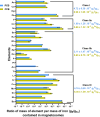Set-up of a pharmaceutical cell bank of Magnetospirillum gryphiswaldense MSR1 magnetotactic bacteria producing highly pure magnetosomes
- PMID: 38419080
- PMCID: PMC10903015
- DOI: 10.1186/s12934-024-02313-4
Set-up of a pharmaceutical cell bank of Magnetospirillum gryphiswaldense MSR1 magnetotactic bacteria producing highly pure magnetosomes
Abstract
We report the successful fabrication of a pharmaceutical cellular bank (PCB) containing magnetotactic bacteria (MTB), which belong to the Magnetospirillum gryphiswaldense MSR1 species. To produce such PCB, we amplified MTB in a minimal growth medium essentially devoid of other heavy metals than iron and of CMR (Carcinogenic, mutagenic and reprotoxic) products. The PCB enabled to acclimate MTB to such minimal growth conditions and then to produce highly pure magnetosomes composed of more than 99.9% of iron. The qualification of the bank as a PCB relies first on a preserved identity of the MTB compared with the original strain, second on genetic bacterial stability observed over 100 generations or under cryo-preservation for 16 months, third on a high level of purity highlighted by an absence of contaminating microorganisms in the PCB. Furthermore, the PCB was prepared under high-cell load conditions (9.108 cells/mL), allowing large-scale bacterial amplification and magnetosome production. In the future, the PCB could therefore be considered for commercial as well as research orientated applications in nanomedicine. We describe for the first-time conditions for setting-up an effective pharmaceutical cellular bank preserving over time the ability of certain specific cells, i.e. Magnetospirillum gryphiswaldense MSR1 MTB, to produce nano-minerals, i.e. magnetosomes, within a pharmaceutical setting.
Keywords: Magnetospirillum gryphiswaldense MSR1; Cell Bank; Fed-batch cultivation; Magnetosome; Magnetotactic bacterium; Minimal medium; Pharmaceutical grade nanoparticle; Scale-up.
© 2024. The Author(s).
Conflict of interest statement
TC, RL, IC and EA declare that they have been working in the start-up Nanobacterie. KB and FG declare that they have no competing interest.
Figures



Similar articles
-
A Method for Producing Highly Pure Magnetosomes in Large Quantity for Medical Applications Using Magnetospirillum gryphiswaldense MSR-1 Magnetotactic Bacteria Amplified in Minimal Growth Media.Front Bioeng Biotechnol. 2020 Feb 18;8:16. doi: 10.3389/fbioe.2020.00016. eCollection 2020. Front Bioeng Biotechnol. 2020. PMID: 32133346 Free PMC article.
-
Effects of Environmental Conditions on High-Yield Magnetosome Production by Magnetospirillum gryphiswaldense MSR-1.Iran Biomed J. 2019 May;23(3):209-19. doi: 10.29252/.23.3.209. Epub 2019 Feb 24. Iran Biomed J. 2019. PMID: 30797225 Free PMC article.
-
The Polar Organizing Protein PopZ Is Fundamental for Proper Cell Division and Segregation of Cellular Content in Magnetospirillum gryphiswaldense.mBio. 2019 Mar 12;10(2):e02716-18. doi: 10.1128/mBio.02716-18. mBio. 2019. PMID: 30862753 Free PMC article.
-
Molecular analysis of a subcellular compartment: the magnetosome membrane in Magnetospirillum gryphiswaldense.Arch Microbiol. 2004 Jan;181(1):1-7. doi: 10.1007/s00203-003-0631-7. Epub 2003 Dec 11. Arch Microbiol. 2004. PMID: 14668979 Review.
-
Magnetosome biogenesis in magnetotactic bacteria.Nat Rev Microbiol. 2016 Sep 13;14(10):621-37. doi: 10.1038/nrmicro.2016.99. Nat Rev Microbiol. 2016. PMID: 27620945 Review.
Cited by
-
Therapeutic Innovations in Nanomedicine: Exploring the Potential of Magnetotactic Bacteria and Bacterial Magnetosomes.Int J Nanomedicine. 2025 Jan 11;20:403-444. doi: 10.2147/IJN.S462031. eCollection 2025. Int J Nanomedicine. 2025. PMID: 39816378 Free PMC article. Review.
References
-
- Abreu FP, Silva KT, Farina M, Keim CN, Lins U. Greigite magnetosome membrane ultrastructure in “Candidatus Magnetoglobus multicellularis”. Int Microbiol. 2008;11:75–80. - PubMed
-
- Alphandéry E, Lijeour L, Lalatonne Y, Motte L. Different signatures between chemically and biologically synthesized nanoparticles in a magnetic sensor: a new technology for multiparametric detection. Sens Actuators B Chem. 2010;147:786–790. doi: 10.1016/j.snb.2010.04.009. - DOI
-
- Alphandéry E, Abi Haidar D, Seksek O, Guyot F, Chebbi I. Fluorescent magnetosomes for controlled and repetitive drug release under the application of an alternating magnetic field under conditions of limited temperature increase (<2.5 °C) Nanoscale. 2018;10:10918–10933. doi: 10.1039/C8NR02164C. - DOI - PubMed
MeSH terms
Substances
Supplementary concepts
LinkOut - more resources
Full Text Sources

